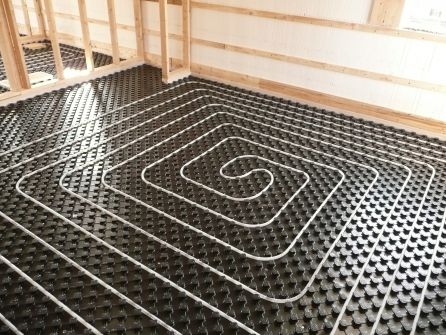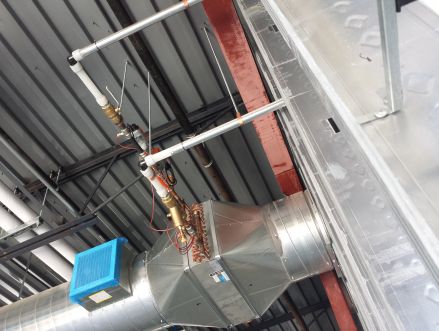In this presentation, Gary Klein shares important information about air source heat pump water heaters (HPWH), with particular attention paid to where the warm air comes ...
PEX for Hydronic Distribution Piping

If you were to ask someone with knowledge of the hydronics industry, “What’s the first thing that comes to mind when you hear the words ‘PEX tubing and hydronics’?” chances are you’ll get such responses as “radiant floor heating or cooling,” “snowmelt systems,” “under-floor heating.” You will also likely hear even the brand names of some of the well-known PEX (crosslinked polyethylene) tubing manufacturers.
If you were to ask the follow-up question, “What size of PEX tubing would be used in a typical hydronic application?” the responses would likely be ½", ⅝" and ¾". That would not be surprising. The majority of PEX usage for hydronic applications is for in-floor radiant installations, with some additional tubing possibly being used for distribution piping to feed the manifolds connected to the radiant loops in the floor.
However, you may also hear smaller sizes like ⅜" or 5/16", or possibly sizes as large as 1". Some might be surprised to learn that PEX piping is available in sizes up to four inches in diameter. These larger sizes are well-suited as risers, or for long horizontal runs to the large-capacity fan coils used in air handling units. Four-inch PEX might also be used as the main trunk that then branches out to smaller sizes to supply hydronic appliances.
Although specifications can vary from manufacturer to manufacturer, some PEX piping does meet the required temperature and pressure ratings needed for certain riser applications, while also having the required oxygen barrier on the tubing to prevent any oxidation on the internal metal components of the hydronic equipment in the system.
In fact, it is quite possible to pipe entire buildings with PEX tubing. Large-diameter supply and return lines can feed directly from boilers and chillers to the various trunk lines (including the risers). This distribution piping can be available in either a two-pipe or a four-pipe system. In addition, PEX tubing can even be used for condensate lines if desired.
Advantages with PEX
 PEX has a proven track record in the hydronics industry, and it has many features and characteristics that make it a highly suitable candidate for distribution piping applications. Its corrosion-resistance, flexibility and durability offer a longer system lifespan, fewer required connections and greater system performance when compared with traditional piping systems, such as copper, black iron and CPVC.
PEX has a proven track record in the hydronics industry, and it has many features and characteristics that make it a highly suitable candidate for distribution piping applications. Its corrosion-resistance, flexibility and durability offer a longer system lifespan, fewer required connections and greater system performance when compared with traditional piping systems, such as copper, black iron and CPVC.
While the use of PEX for distribution piping is not as common as traditional piping materials, PEX is a great fit for many applications, especially for those linked to hydronic systems. After all, PEX and hydronics do go hand-in-hand quite nicely and already have a well-established history together.
Baseboard radiators, VAV (variable air volume) boxes, chilled beams and fan coils units are all common types of hydronic-based heating and cooling systems. Many of these can easily connect to PEX as their distribution piping source. Although some of these appliances require threaded or sweat connections, PEX-to-sweat and PEX-to-thread brass adapters are available in various sizes, so connecting these hydronic units to PEX lines is an easy task.
Plus, the flexibility of PEX tubing and its availability in long coil lengths make it well suited for piping or re-pipe applications to baseboard radiators. Installers can leverage this length and flexibility to minimize connections, reducing the need for elbows.
Using PEX for distribution piping in residential buildings to supply hot water to baseboard radiators is really a great option. For example, baseboard radiators may be using 180°F supply water at a flow rate of 1.5 gallons per minute (gpm). Half-inch diameter PEX tubing would be able to handle up to four gallons per minute of flow rate, making it an excellent candidate for distribution piping consideration.
PEX tubing coils can vary in length from 100 feet to 1,000 feet. Straight-stick lengths are 20-feet. Either type can accommodate PEX support channels for suspended piping applications to ensure a professional-looking installation.
Changes from traditional installation methods
 Contractors use PEX for the first time — rather than the copper, black iron or CPVC pipe they have been using for years —may decide to use straight sticks of tubing. After all, that is what is most familiar to them. But, despite an installer’s comfort factor aside, 20-foot sticks may not be the most efficient option for a project.
Contractors use PEX for the first time — rather than the copper, black iron or CPVC pipe they have been using for years —may decide to use straight sticks of tubing. After all, that is what is most familiar to them. But, despite an installer’s comfort factor aside, 20-foot sticks may not be the most efficient option for a project.
One of the key advantages of coils over straight lengths of pipe is the reduction in waste material. The coils can be cut to the exact length that is needed. This helps to minimize the number of connections required by long pipe runs.
Take, for example, a project that requires a three-inch supply line through a building, with 400 feet between the mechanical room and the first point where it is necessary to make branches in the supply line. A 300-foot coil of three-inch PEX can be added to a 100-foot coil, resulting in only one connection point over the combined 400-foot length. Using 20-foot lengths of pipe would require a total of 19 connection points to get the same result.
In an application like this, continuous-length coils therefore deliver significant labor savings with fewer potential leak points. Coiled pipe is also available pre-insulated with multilayer foam insulation and an outer HDPE jacket that can be directly buried under slabs or between buildings.
Speaking of direct-burial applications, the flexibility that PEX provides, especially with coils, allows for slight bends in the pipe to get around any underground obstacles such as tree roots or large boulders that obstruct a straight-line approach. In addition, the pipe trenches need not be level: The flexible pipe simply bends to conform to the site’s topography.
For riser applications, coils can often be hoisted to the top of a structure and fed down through the building as a single line. Installers can also cut into the pipe to make branch connections where needed.
It’s easy to see that PEX is a viable option for a variety of hydronic distribution-piping applications on both residential and commercial projects. With its durability, flexibility, range of sizes, system-performance characteristics and labor-saving benefits, PEX need no longer take a back seat to traditional metallic materials in the design and installation of a distribution piping system.
Jerry Leyte, P.Eng., MASc., is the sales manager for Central Canada at Uponor. He can be reached at [email protected].
Leave a comment
Related Posts

In this all-technical three-hour seminar, Dan Holohan will give you a Liberal Arts education in those Classic Hydronics systems. He’ll have you seeing inside the pipes as...
We always have turkey for Thanksgiving. I mean who doesn’t? My job wasn’t to cook it, though; it was to eat it.